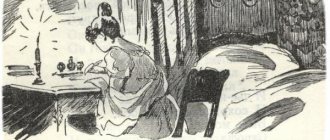History of creation
The poet was serving a southern exile, so he lived and worked in Odessa. Alexander Sergeevich worked in the office, where his head was Count Mikhail Vorontsov. The men got along very well, they could even be called friends to some extent. But their good relationship ended abruptly when Alexander Sergeevich met the count’s wife, whose name was Elizaveta Vorontsova.
At their first meeting, the poet noted that Elizabeth was beautiful both externally and internally - she had an excellent education and could support any topic of conversation. The first sympathy very soon grew into a more serious and mutual feeling. Moreover, the girl did not keep her relationship with the poet a secret from her husband. Mikhail Vorontsov took this calmly for the time being, until gossip spread throughout the city. Then he made efforts to ensure that Alexander Sergeevich left the city in the near future.
It was this girl who gave the poet a gift in the form of a ring, which became a talisman for him for life.
Alexander Sergeevich realized that he was unlikely to ever see his beloved again. The lovers corresponded for quite a long time, but Elizabeth asked the poet to immediately destroy her messages. The poet did not agree with this request, but did not dare to disobey his beloved. One day, during a surge of feelings, Alexander Sergeevich writes the work “Burnt Letter”. This poem dates back to 1825.
Subject
In the work “The Burnt Letter,” the theme of love is explored in a very unusual manner. The lyrical hero turns to a letter from his beloved, but in fact we are talking about departed love. The letter is only a means of conveying the emotional experiences of the lyrical hero, which gives special meaning to the destruction of the love letter. So he says goodbye not only to the letter, but also to love, which is leaving him forever.
Throughout the poem, the mood of the lyrical hero changes: he either calms down, then again begins to rush around convulsively, suffering from his heart wounds. Even in the burnt ashes, he sees the image of his beloved, and wants to keep it forever in his heart.
The main idea of the work is that it is necessary to keep your word given to your loved one, no matter how difficult it may be to do so. The lyrical hero passionately dreams of leaving at least letters to his beloved woman, with whom he was once so happy, as a keepsake. However, he is forced to submit to her request to burn all the messages, and is tormented by the fact that he is losing the last thread that connected them with his beloved.
Images and symbols
The author himself is represented in the image of the lyrical hero, who thus conveys his feelings and state. He burns a message that is very dear to him. But he has no right to resist the woman he loves. Although writing is life-giving moisture for him, a source of inspiration and strength, the author needs to say goodbye to all this. He wants to forget about the past, which once brought him so many happy days and moments. But it is irrevocable, so it would be wiser to end it.
There is also an image of the letter itself. With its help, the author tries to depict that invisible thread that still connects him with his beloved woman. Although the young people were already more friends than lovers, this ghostly connection means a lot to the poet. He treats the letter as a kind of treasure that he has been waiting for a very long time. That is why it is quite difficult for him to burn such a dear message.
You can also highlight the image of fire, which in this poem symbolizes a certain purification, although it mercilessly burns such precious sheets of the message.
Another image is present in the poem “Burnt Letter” - this is the image of burning leaves. The author shows them as living beings who feel pain. They symbolize what is happening at this moment in the poet’s soul. Even ashes are dear to the poet.
Theme of the work
One thing is certain: Pushkin’s feelings were very deep and respectful. The messenger ordered, but the lyrical hero for a long time could not fulfill her will - to put the letter on fire. In all likelihood, he repeatedly reread the sweet lines written by his beloved hand.
They contained all his joys in a lonely cell, as the lyrical hero in another work called his office. But the hour of final parting has come. The letter was thrown into the fire, the hero’s soul renounced the whole world and became empty. He just silently watched as the message flared up, melted and boiled sealing wax, as the sheets curled up and gradually turned into ashes.
The letter has left the lyrical hero forever, but memory and love remain in the sore chest. What does the theme of “The Burnt Letter” tell us? The analysis spoke about the hesitations of the lyrical hero, about his nobility in relation to his distant beloved, whose desire even at a distance becomes an immutable law for him. About the grief of his precious loss. The lyrical hero sees the final collapse of his dream.
Composition
In this poem, the poet uses linear composition. The poem consists of three quatrains and one tercet.
In terms of meaning, the work can be divided into three parts. In the first part we see the poet turning directly to writing. The poet wants to say goodbye to him.
Farewell letter of love, farewell! She ordered...
How long did I hesitate, how long did I not want to
Hand consign all my joys to fire!..
But it’s complete, the hour has come: burn, a letter of love.
In the second part of the poem, the author burns the message, watching as his hopes and dreams burn along with it.
The greedy flame is already accepting your sheets...
Just a minute!.. flared up... blazing... light smoke,
In the final part of the work, the poet turns to the ashes.
They turn white... My chest feels tight. Ashes dear,
Poor joy in my sad fate,
Stay forever with me on my sorrowful chest...
Analysis of Pushkin’s poem “The Burnt Letter”
In the summer of 1823, Alexander Pushkin, being in southern exile, sought a transfer from Chisinau to Odessa. He enters the service in the office of the mayor, Count Mikhail Vorontsov, with whom the poet initially develops quite friendly relations. Pushkin entered the count's house, and often entertained numerous guests with his poems during social receptions. Everything changes after he meets the count’s wife, Elizaveta Vorontsova, at one of the receptions. Being in the last months of pregnancy, the woman looks tired and painful, evoking sympathy from the poet. But when six months later he meets her at the traditional governor’s ball, he is amazed, since in front of him is not only a socialite, distinguished by her amazing beauty, but also a very erudite person, who is also interested in literature.
The romance between Pushkin and Vorontsova breaks out literally from the first minutes of close communication. Moreover, the count’s wife, due to her progressive views, does not even consider it necessary to hide this fact from her husband. And soon rumors spread throughout Odessa that Vorontsov had become a cuckold, as well as a public laughing stock. Naturally, the rather liberal count could no longer tolerate this, so he made every effort to expel Pushkin from the city. The poet's departure to Moscow took place in 1824, and as a farewell, Elizaveta Vorontsova gave the poet a ring with carnelian and an old engraving on the stone. She still has exactly the same paired ring as a reminder of her love for the poet.
Pushkin knew that he was unlikely to ever see his beloved again and did not want to put up with it. In turn, Elizaveta Vorontsova insisted on ending the relationship. Nevertheless, after the poet left Odessa, the lovers corresponded for some time, sealing their messages with signet rings. However, each time the countess set the condition that letters that compromised her be burned by the poet.
In 1825, after another message from the countess was set on fire, Pushkin wrote the poem “The Burnt Letter,” in which he noted with bitterness that he was unable to violate the will of his beloved. “How long have I hesitated! How long do you not want to hand over all my joys to the fire! ”, noted the author. However, the duty of honor turned out to be higher than feelings, so a few minutes of hesitation pass, and “the greedy flame is already accepting your sheets.” The letter, which the poet considers priceless, gradually turns into a pile of ashes and “the faithful ring has lost its impression, the melted sealing wax is boiling.”
At these moments, Pushkin is experiencing real despair, since the letter from the countess is the little that remains of their love. However, the poet is even more oppressed by the need to destroy it with his own hands and, thereby, deprive himself of the opportunity from time to time to re-read lines full of love and tenderness. It is worth noting that at this time Pushkin is in yet another exile, and is forced to live permanently in the family estate of Mikhailovskoye. Therefore, a letter from Elizaveta Vorontsova is a breath of fresh air for him, reminding him not only of the happy days he spent in Odessa, but also of his lost freedom. In addition, the poet’s passionate and ardent nature craves love; he needs to always have a woman nearby for whom he would experience similar feelings, expressing them in poetic form.
But the only thing that remains for the poet in this situation is to keep the “dear ashes” on his “sorrowful chest,” hoping only that someday fate will give him the opportunity to see again the one who became the poet’s muse for five long years, inspiring him to creation of a cycle of lyrical love poems.
The poem “Burnt Letter” by Alexander Sergeevich Pushkin belongs to love lyrics, and fully reveals the poet’s emotional experiences. We invite you to familiarize yourself with a brief analysis of “The Burnt Letter” according to a plan that will be useful to 9th grade students in preparing for a literature lesson.
Topics, problems
The main theme of the work is, of course, love. The author shows unhappy love, which brings only disappointment. Yes, he was happy, these are the memories he tries to preserve. These feelings brought the poet nothing but pain. For such a short time of happiness, the poet had to pay with prolonged sadness.
He writes these lines on the verge of despair. You can hear and feel the pain that tears the poet apart. Almost all the lines of the poem are filled with them. He suffers from separation, realizing that he is unable to change anything.
He lives only with memories of his past love, so it is very difficult for him to turn the page of his life. He loves this woman, so he tries to fulfill all her wishes, even despite his happiness.
Means of expression
With the help of various kinds of tropes, the author more clearly conveys his state of mind and mood.
The use of epithets well reveals the poet’s feelings, giving them colors and shades.
Personifications convey the emotional state of the poet, conveying his feelings and state of mind.
Thanks to metaphors, the poet manages to create a unique imagery of the work, making it incredibly beautiful.
The author also uses inversion. With its help, he manages to add melody to the poem.
Ideological and structural analysis of the work
The text is written in iambic pentameter. The adjacent rhyme and stress on the second syllable create a special atmosphere of strong emotions and experiences.
The text has a fairly fast pace, which sets the general emotional atmosphere: a storm of feelings, bitterness and regret.
A special rhythm to the text is also set by the transitions of the hero’s mood: only after calming down, the character immediately plunges into suffering. Or, having seemingly finally made a decision, he again plunges into thoughts about its correctness.
Among the expressive means used, the following stand out most clearly:
- Personifications: “greedy flame”, “sweet ashes”, etc.;
- Metaphors: letter, flame;
- Epithets: “sorrowful”, “sad”;
- Gradation: “flashed” - “blazing” - “smoke”;
- Repetitions: “how long.”
Also uses such a figure of speech as inversion. For example, “how long did I hesitate.”
It is impossible not to mention the abundance of exclamation marks and ellipses that alternate. And in addition to being a means of conveying emotions, they serve the function of setting an additional rhythm, where quiet periods of “silence” contrast with strong feelings.
In this poetic work by Pushkin, morphological forms are presented in various incarnations, which enriches the overall textual composition.
The lexical and semantic composition of “The Burnt Letter” is distinguished by its expressiveness and contrast. Through this, the author, in an unusual manner, enhances the impact of the lines on the reader and gives additional weight to what is said.
Main thought
The main idea that the author put into the poem can be called the poet’s farewell to his former love. He reminisces, realizing that he needs to turn the page of his life and continue his existence from scratch. But even the elements have no power over the poet’s feelings. The fire burns the paper, but not the memory of the woman he continues to love.
Yes, you can burn the letter, but the ashes will still remain, which will constantly remind you of past happiness.
It is very difficult to forget and erase from life the moments when you were truly happy. You are ready to keep even the ashes. These are the memories that hurt, but it is a very sweet pain. Pushkin understands that it’s time to end this and start living again. He even seems to decide to do this, burning letters from his beloved. But at the last moment he agrees to keep even the ashes, so long as the memories do not leave him!








